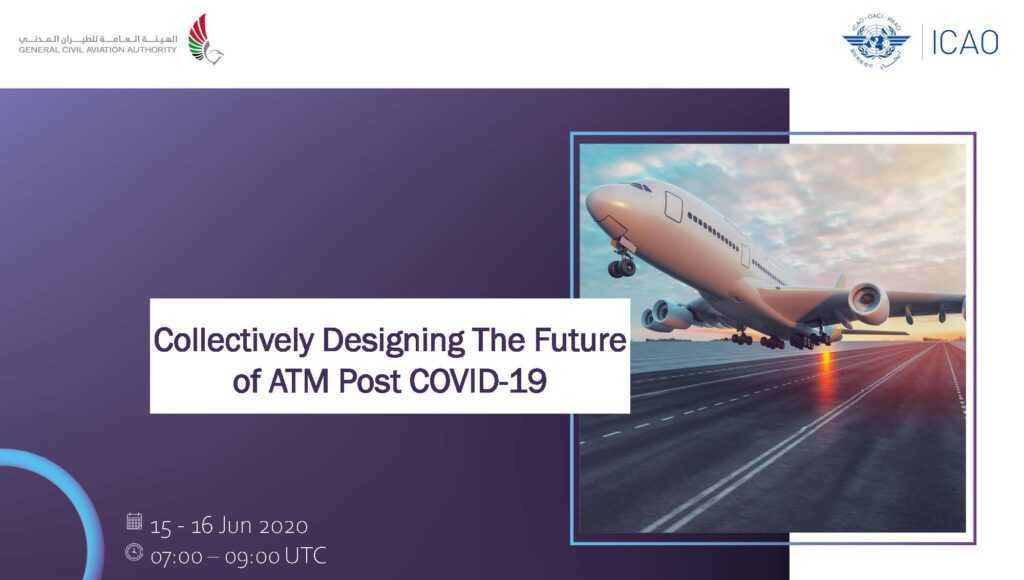The COVID-19 pandemic has profoundly and economically impacted every aspect of the aviation industry. To understand the challenges that various States and industry members have encountered as they navigated through the early and current phases of the pandemic, ICAO’s MID Regional Office and the General Civil Aviation Authority (GCAA) of UAE jointly organized a webinar to bring participants together to share knowledge and experiences.
The Webinar, which took place from 15-16 June 2020, brought together 862 participants from 144 organizations comprised of Civil Aviation Authorities, ANSPs, ATM suppliers, airlines, travel agencies and universities. Their objective was to discuss pandemic contingency planning and management, collective areas of common priorities, and to share recommendations and solutions.

The Strength of the 3Cs: Cooperation, Collaboration and Communication
The first session of the webinar looked at the impact COVID-19 had on travel and tourism, passengers, traffic and national economies. The challenges included:
- lack of aeronautical information;
- the need to ensure that the network remains available, emergencies and route alternatives;
- overflight approvals;
- crew restrictions;
- skilled staff availability;
- ATM infrastructure;
- Radio Navigation flight inspection; and
- safety risk management
Effective communication and the updates provided on the ICAOMID COVID-19 and ICAO COVID-19 webpages, the MID RPTF platform, ACAO webpage and CANSO guidance materials helped States with their planning, implementation and response to the crisis. The Inter-organizational collaboration is crucial to avoiding duplicated efforts and fragmented measures post COVID-19 to supporting the aviation industry’s restart and recovery. Many airlines began resuming operations and it was noted that ensuring the 3Cs between all stakeholders and supply chain players was essential in ensuring a smooth restart.
Uniting to prevail through COVID-19: a cohesive outlook
Many different actions were taken throughout the COVID-19 pandemic that include inter-alia:
- reviewing contingency plans on a regular basis;
- resource optimization;
- raising awareness;
- focusing on repatriation flights to minimize impact on the supply chain;
- expanding cargo capacity by granting airline exemptions to carry cargo on passenger compartment;
- strengthening coordination with neighboring ANSPs;
- maintaining ATCOs proficiency by using simulators to manage complex ATS scenarios;
- enhancing some ATS routes on a temporary basis between Oman and UAE;
- ensuring that staff is ready to perform once operations restart;
- forming different committees dealing with different crisis management aspects;
- defining different scenarios/actions to manage the crisis based on the safety risk management methodology.
The panel advised ANSPs to take advantage of this low traffic period to prepare for the future users’ demands and discussed the UAE initiative of refining ANS strategy to optimize resources/costs and enhance existing procedure and strategies. They noted the importance of collaborating and coordination at national and regional levels to refine existing strategies and the way forward with the most expeditious, efficient and cost-effective solutions.
Third Session: MID Region Aviation Restart and Recovery
This session involved discussions on how to reduce the spread of COVID-19 by air transport and how to protect the health of air travellers and aviation personnel while maintaining essential air transport operations and ensuring an orderly return to normal operations in due course.
The ICAO MID Regional Office, in coordination with the international and regional organizations established the MID Region Recovery Plan Task Force (RPTF). The objectives of the RPTF are to:
- become a single Regional source of information, Guidance materials and best practices to States and stakeholders;
- support the response to crisis, restart and recovery in the Region & encourage harmonization; and
- support cross-border restart and recovery.
Their work involves four technical work-streams:
- Stream 1: Public Health Requirements/measures and Airport infrastructure
- Stream 2: Operational Safety Measures
- Stream 3: Security and Facilitation
- Stream 4: Air Traffic Management
More information on the key activities and deliverables are shared in the recap from the Webinar shared here.

Fourth Session: Technology VS COVID-19
The last panel was focused towards Technology and its role during and after the COVID-19 Pandemic where a few the globally leading ANS Suppliers discussed various topics and provided insight into the Business and projects side of ATM during and post the COVID–19 Pandemic. The session addressed the topics below:
- Managing Worldwide ATM systems deployment and maintenance during the pandemic.
- The planning and change processes during and post COVID-19 for the recovery and resumption of projects around the world.
- Show the future path of ATM systems and identify where new areas are created and where current ones might change.
- Give a glimpse of what is being prepared for launch by the suppliers in the near future to support their customers.
COVID-19 will have three phases of impact on air transport: initial, current and future. In the initial phase of the pandemic, suppliers agreed that the safety of their personnel and security of their assets took first priority. The challenges during that phase were mainly revolving towards access to their facilities and how the situation was affecting the supply chain, while in the current and future phases the challenges involved service and investment priorities.
Because of technology, many functions resumed almost immediately. Some changes to activities that were previously carried out in person involved Factory Acceptance Tests (FAT) and Site Acceptance Tests (SAT). These were conducted successfully via remote access and virtual conferencing applications.
The panel explained how they maintain their support to safety-critical systems like ATM systems through a combination of local and remote solutions. Local solutions included physical support personnel and the use of support and maintenance training allowing the customers to conduct these activities under the supervision of the suppliers. Remote solutions utilized remote access to the systems through secure connections.
The role of cybersecurity was highlighted with all panellists stressing the importance of investing adequately in cybersecurity through the explanation of the rising threats due to various factors including:
- Increase of personnel stress levels which makes them prone to mistakes leading to cyber-security vulnerabilities.
- Lack of personnel’s knowledge and awareness of correct cybersecurity measures.
- Hackers’ targeting of critical infrastructure as they are considered as high-value targets.
The dominating factors of recovery planning was shared by the suppliers and it was explained how survival and business continuity came first, followed by re-prioritisation of products and services and reaching to looking for new opportunities using data analysis and think tanks.
Enhanced communication between the suppliers and their customers proved extremely valuable to the extent that initiatives are being established to keep this communication level in place through digital forums and that collaboration cleared “Grey areas” that could have led to safety implications.
All of the outcomes from these discussions are shared in the recap from this Webinar. The meeting was recorded in its entirety and is also shared, here.

